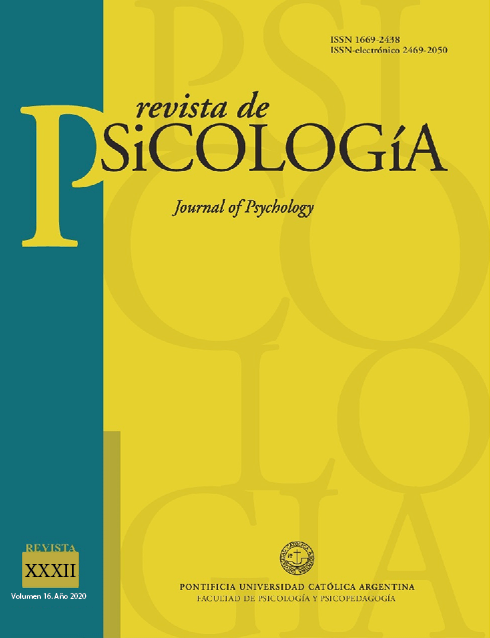Definiciones y niveles de bullying en una muestra de adolescentes argentinos
DOI:
https://doi.org/10.46553/RPSI.16.32.2020.p7-23Palabras clave:
bullying, definición, adolescentes, argentinosResumen
Introducción: el bullying es un importante factor de riesgo para la salud mental de los adolescentes. Propósito: explorar las definiciones de bullying que brindaban los adolescentes. Muestra: se constituyó una muestra de 202 adolescentes de Paraná, Argentina. Instrumentos: The Cartoons Task de Smith, la pregunta abierta de Vaillancourt y el cuestionario de Olweus. Resultados: sólo un 8% indicaba el desbalance de fuerzas, un 4%, la repetición y un 10%, la intencionalidad en su definición. En la tarea de Smith, la gran mayoría podía identificar las viñetas que eran bullying, pero también se incluían situaciones que no eran acoso como bullying. Conclusión: las definiciones sobre qué es bullying dada por los adolescentes coinciden solo parcialmente con su definición científica.Descargas
Citas
Adornetto, J. (2016). Acoso escolar: definiciones de acoso escolar en adolescentes (Tesis de grado). Universidad Argentina de la empresa, Buenos Aires, Argentina.
Card, N. A., Isaacs, J., & Hodges, E. V. (2007). Correlates of school victimization: Recommendations for prevention and intervention. En J. E. Zins, M. J. Elias, & C. A. Maher (Eds.), Bullying, victimization, and peer harassment: A handbook of prevention and intervention. Nueva York: Haworth Press.
Cheung, F. M., van de Vijver, F. J. R., & Leong, F. T. L. (2011). Toward a New Approach to the Study of Personality in Culture. American Psychologist, 66(7), 593-603 doi: 10.1037/a0022389
Costa, P. T., Jr., & McCrae, R. R. (1992). Revised NEO Personality Inventory (NEO-PI-R) and NEO Five-Factor Inventory (NEO-FFI) professional manual. Odessa, FL: Psychological Assessment Resources.
Craig, W., Pepler, D., & Blais, J. (2007). Responding to bullying what works? School Psychology International, 28(4), 465-477.
Juvonen, J., & Graham, S. (2001). Peer harassment in school. The plight of the vulnerable and victimized. Nueva York: Guilford Press.
Kyriakides, L., Kaloyirou, C., & Lindsay, G. (2006). An analysis of the Revised Olweus Bully/Victim Questionnaire using the Rasch measurement model. British Journal of Educational Psychology, 76(4), 781–801.
Nansel, T., Overpeck, M., Pilla, R., Ruan,. W., Simons-Martin, B., & Scheidt, P. (2001). Bullying behavior among U.S. youth: prevalence and association with psychosocial adjustment. Journal of the American Medical Association, 285(16). 2094-2100.
Olweus, D. (1993). Bullying at school: What we know and what we can do. Cambridge, MA: Blackwell.
Olweus D. (1996). The Revised Olweus Bully/Victim Questionnaire. Bergen, Noruega: HEMIL, Universidad de Bergen.
Olweus, D. (2013). School bullying: Development and some important challenges. Annual Review of Clinical Psychology, 9, 751-780.
Paul, J., & Cillessen, A. (2003). Dynamics of Peer Victimization in Early Adolescence Results from a Four-Year Longitudinal Study. Journal of Applied School Psychology, 19(2), 25-43.
Phillips, V., & Cornell, D. (2012). Identifying victims of bullying: Use of counselor interviews to confirm peer nominations. Professional School Counseling, 15, 123-131.
Resett, S. (2011). Aplicación del cuestionario de agresores/víctimas de Olweus a una muestra de adolescentes argentinos. Revista de Psicología de la UCA, 13(7), 27-44.
Resett, S. (2014). Bullying: víctimas, agresores, víctimas-agresores y correlatos psicológicos. Actas Psiquiátricas y Psicológicas de la América Latina, 60(3), 171-183.
Resett, S. (2017, agosto). Definiciones del bullying en adolescentes. Trabajo presentado en el VIII Congreso Internacional de Educación, Santa Fe, Argentina.
Resett, S. (2018). Análisis psicométrico del Cuestionario de Agresores/Víctimas de Olweus en español. Revista de Psicología de la PUCP, 36(2), 575-602.
Rigby, K., Smith, P., & Pepler, D. (2004). Working to prevent school bullying: Key issues. En P. K. Smith, D. Pepler, & K. Rigby (Eds.), Bullying in schools: How successful can interventions be? (pp. 112) Cambridge: Cambridge University Press.
Runyon, M., Kenny, M., Berry, E., Deblinger, E., & Brown, E. (2006). Etiología y vigilancia en el maltrato infantil. En J. Lutzker (Ed.), Prevención de violencia. Investigación y estrategias de intervención basadas en la evidencia (pp. 21-44). México: Manual Moderno.
Smith, P., Cowie, H., Olafsson, R., & Liefooghe, A. (2002). Definitions of bullying: A comparison of terms used, and age and sex differences, in a 14-country international comparison. Child Development, 73, 1119-1133.
Smith, P., del Barrio, C., & Tokunaga, R. (2012) Definitions of bullying and cyberbullying: How useful are the terms? En S. Bauman, J. Walker, & D. Cross (Eds.), Principles of cyberbullying research. definitions, measures and methodology (pp. 26-40). Nueva York y Londres: Routledge.
Smith, P. K., Kanetsuna, T., & Koo, H (2007). Cross-national comparison of ‘bullying’ and related Terms: Western and Eastern perspectives. Contemporary research on aggression: School violence. World Meeting of the International Society for Research on Aggression,3, 3-9.
Smith, P. K., Kwak, K., Hanif, R., Kanetsuna, T., Mahdavi, J., Lin, S., Olafsson, & Ucanok, Z. (2016). Linguistic issues in studying bullying-related phenomena: Data from a revised cartoon task. En P. K. Smith, K. Kwak, & Y. Toda (Eds.), School Bullying in Different Cultures: Eastern and Western Perspectives (pp- 280-298). Cambridge: Cambridge University Press.
Ucanok, Z., Smith, P. K., & Karasoy, D. (2011). Definitions of bullying: Age and sex differences in a Turkish sample. Asian Journal of Social Psychology, 14, 75–83. doi: 10.1111/j.1467-839X.2010.01334.x
Vaillancourt, T., McDougall, P., Hymel, S., Krygsman, A., Miller, J., Stiver, K., & Davis, C. (2008). Bullying: Are researchers and children/youth talking about the same thing? International Journal of Behavioral Development, 32(6), 486–495.
Wisdom, J., & Creswell, J.W. (2013). Mixed Methods: Integrating Quantitative and Qualitative Data Collection. Rockville, MD: Agency for Healthcare Research and Quality.
Descargas
Publicado
Cómo citar
Número
Sección
Licencia



















